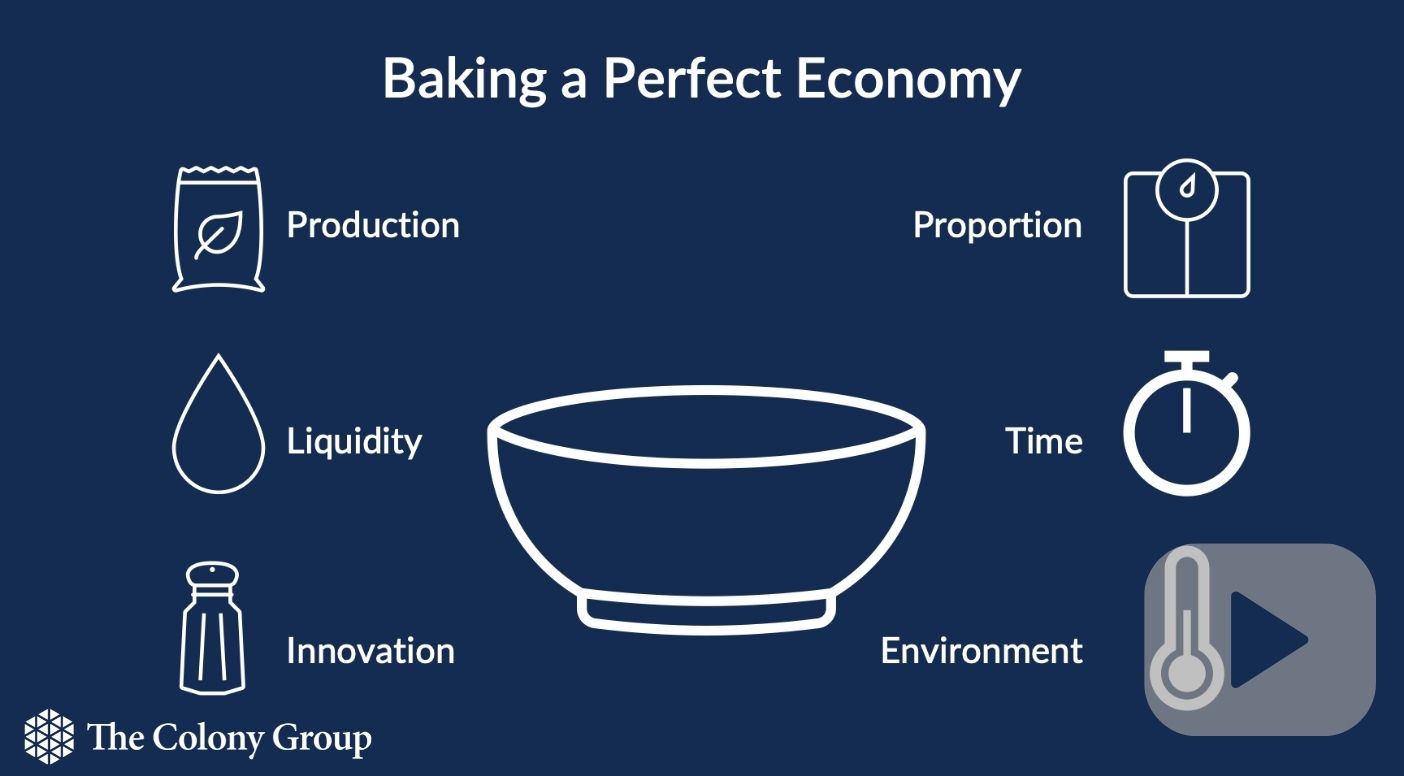What do well crafted sourdough and inflation have in common?
VIDEO TRANSCRIPT:
Well crafted sourdough and inflation have a lot in common. For both, you need more than the right ingredients (Flour, Water, and Salt or Production, Liquidity and Innovation). To get a good outcome, you need them in the right proportions with the right amount of time and the you need the right environment.
The proportions are key. Many bakers precisely measure out their inputs using a scale that goes down to a single gram. Too much flour, and you’ll have a dry brick. Too much water and you’ll have soup. Too much salt and your bread won’t rise (and if you have too little, it will rise too fast).
In today’s environment, production, or GDP, is strong. It’s bounced sharply off the pandemic lows and is well on its way toward reaching its potential.
Liquidity is ample. Some might say too ample. The Fed’s balance sheet is expected to cross $9 Trillion soon. While they are expected to slow the pace of its growth, it’s unlikely to head in the other direction anytime soon.
Innovation is happening. New business formations are remarkably strong. This can be a leading indicator for new products, services, and competitors in tight markets. With the right amount of it, innovation can both ignite an economy with new ideas but also provide downward pressure on inflationary prices by offering substitutes and ways to cut costs.
Underestimated by many bakers is the environment in which they are baking- and this is more than just the oven temperature. If your kitchen is too cool, the bread rises very slowly.
Very slowly.
But it eventually gets there. In the economy, cool economic growth tends to lead to slower price changes.
Alternatively, if it’s too hot. It rises too quickly.
When we look at the temperature, it’s beginning to feel a little warm. The Consumer Price Index’s recent readings are well over the Fed’s longer-term targets. But notably, they’ve been above target before (and generally not for very long).
The thermostat also has its critics. The Cleveland Federal Reserve, for example, has offered its own measures of inflation like looking at only the median price move in a basket of goods or eliminating the top/bottom movers. Both of these are showing substantially lower inflation than the headline numbers. It’s a convenient time to look at these kind of statistics because there are a few areas that are really distorting the headline inflation numbers.
Particularly those areas that were hardest hit by the pandemic- either because of supply chains or lack of demand last year. Energy is having a strong rebound after a year of lower usage. Restaurants, airlines, rental cars are experiencing big rebounds. And after a year with limited car production and few people trading in their old cars for new ones, everyone came back into the market and manufacturers haven’t been able to keep up.
Indeed, these pandemic related categories only have a 27% weight in the Consumer Price Index but they contributed 77% of last month’s gains!
Year-over-year, the used car in your garage has potentially risen 45% in value! But unless you bought/sold a used car in the last few months, this inflation doesn’t apply to you.
If we look at CPI excluding Airfares, Hotels, Events, New and Used Cars, and Rental Cars, we’re below the pre-pandemic trend.
The good news is that time can (sometimes) make up for a bad environment. Like bread, the economy can handle short bursts of hot air. As long as that air is “transitory” as-in it doesn’t stick around for very long, you can still end up with a delicious bread (or economy) at the end.
And some of the early parts of the economy that seemed to overheat are already self-correcting. Remember just a few months ago when every headline talked about the skyrocketing price of lumber? It’s come back down more than 60%.
Other prices are likely to go back down, too. As supply shortages allow new car production to resume in earnest, people will buy new cars (and trade in their old ones). Price resets on cars can happen relatively quickly. They may (or may not) go back quite as low as they were, but they’re not particularly sticky at high levels.
But other areas are harder to reverse. There are growing signs of wage inflation, particularly in lower-paying jobs.
Employers who try to cut employee wages, are likely to see their employees flee.
But they can slow it by not continuing the same increases next year.
And with enough time and innovation, automation and productivity improvements tend to slow aggregate wages (and inflation).
Baking bread is hard. Getting inflation right is hard. We seem to have all the right ingredients for a great outcome but will the heat in the economy ruin it? Or will time prove that the temperature blast is just transitory? Only time will tell, but for now, it looks manageable.
